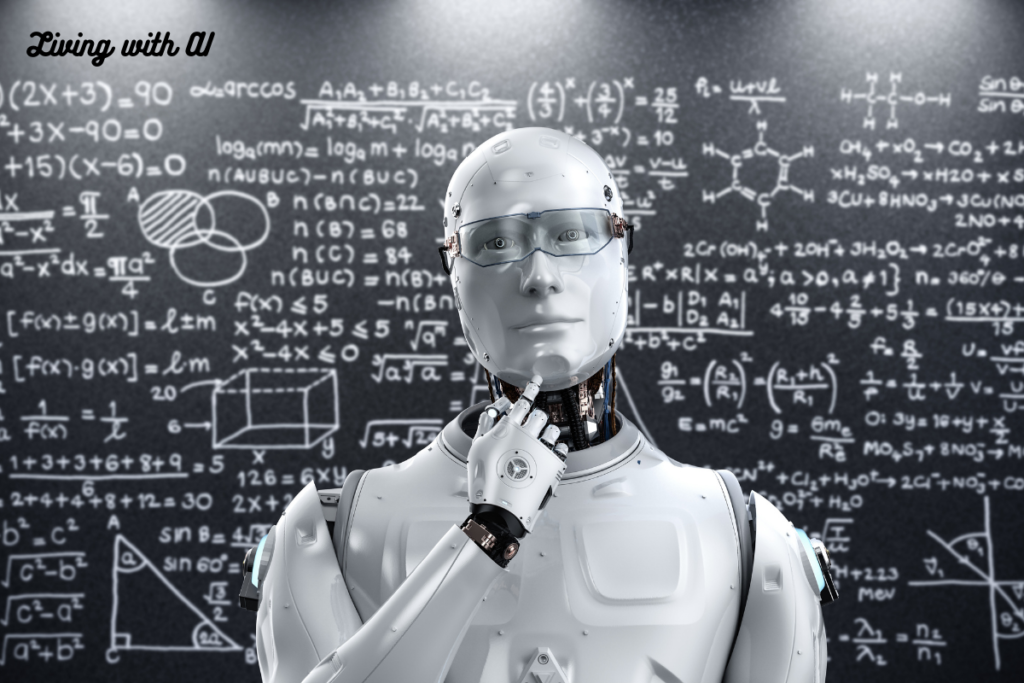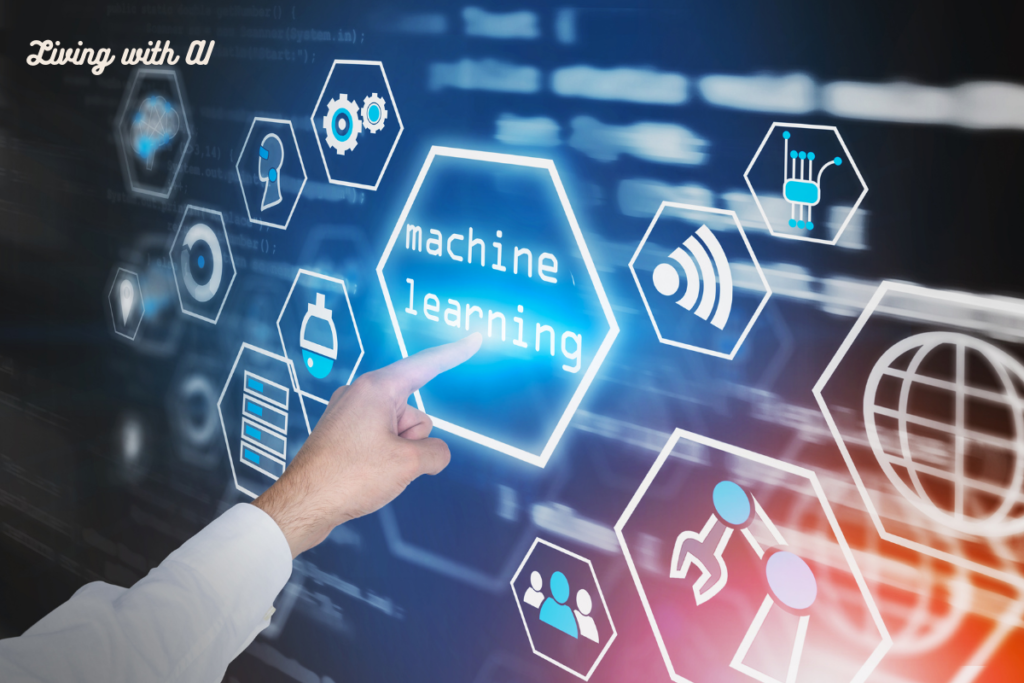Introduction:

It is becoming more common in today’s fast-paced world to use artificial intelligence (AI) in our daily lives. We use technology to make our daily lives better in many ways. The phrase “Living with AI” sums up these ways. Machine learning has a big impact on our habits and actions. It’s used in everything from smart home devices to personalized suggestions on streaming services.
We enjoy benefits that make things easier and faster now that we “live with AI.” Virtual assistants, for example, can help us keep track of our plans, and algorithms can find news and entertainment that fits our tastes. This tailored method not only saves us time, but it also lets us discover new interests that we might not have found any other way.
Also, AI systems look at huge amounts of data to give people ideas that help them make better decisions in areas like healthcare, education, and transportation. In the healthcare field, for example, machine learning can help doctors make more accurate diagnoses by finding trends in medical data that people might miss.
However, “living with AI” also brings up important questions about privacy, safety, and morality. It’s important to think about how our data is used and what that might mean for society as we become more dependent on these tools.
To sum up, “Living with AI” is about embracing the ease and speed that machine learning brings to our daily lives while also being aware of the responsibilities that come with this technological shift. By understanding its effects, we can live more informed and balanced lives.
Table of Contents
Personalized Experiences:

“Living with AI” these days means having a very customized online experience. Algorithms that are driven by AI are at the center of this change; they carefully look at users’ likes and dislikes and behaviors to create content that is perfectly suited for each person. This includes music playlists that seem to perfectly match your mood and shopping suggestions that match your tastes. AI makes sure that your online interactions feel like they are completely unique to you.
Streaming services like Spotify and Netflix use machine learning to keep track of what you’ve listened to and watched, then they use that information to suggest new artists or shows you might like. Similarly, e-commerce platforms look at what you’ve bought and how you’ve browsed in the past to suggest products that fit your style and needs. This personalization not only makes things easier, but it also makes everything you do online more natural and interesting.
AI personalizes your world by knowing your likes and dislikes and guessing what you’ll need. This is just one example of how we live with AI today.
Smart Home Integration:
“Living with AI” includes our homes, where smart devices make our living spaces more responsive and energy-efficient. AI-powered smart home technology, like lighting systems and thermostats, learns and adjusts to our daily habits, making our lives easier and more comfortable than ever.
Imagine walking into a house where the lights are dimming and the thermostat has already been set to the perfect temperature for the evening, all without you having to do anything. This is possible thanks to AI, which watches how things are used and the environment to make changes in real time that make things more comfortable and save energy.
Smart lighting systems change the color and brightness of lights based on the time of day and how much you’re using them. Smart thermostats learn from how you use heat and air conditioning and make changes to save energy. This kind of intelligent automation not only makes your life easier, but it also helps the environment by reducing energy waste.
“Living with AI” is now possible thanks to smart home integration. This shows the usefulness of technology that learns from and helps its users, making living places that are harmonious and fit each person’s lifestyle.
Virtual Assistants:

Everyday virtual assistants like Siri, Alexa, and Google Assistant are a great example of “living with AI.” These AI-powered tools have become an important part of managing all the things we have to do, and we can ask them for help with anything.
The power of AI is used by virtual assistants to make daily tasks easier and more organized. These assistants make sure we never miss a beat by reminding us of important dates and meetings, making to-do lists, and managing our calendars. They can also answer a wide range of questions in seconds, from giving us weather and traffic updates to trivia questions and quick math problems.
Virtual assistants give us a whole new level of convenience and connectivity by letting us control smart home devices, play music, and make calls. As they learn from our interactions and preferences, they get better at tailoring their responses and suggestions to meet our specific needs.
Living with AI is all about virtual helpers, which make it easier to keep track of tasks and get information at any time. They make us more productive and improve our everyday lives by integrating technology in a seamless way.
Enhanced Communication:

“Living with AI” has changed the way we talk to each other by removing barriers and streamlining processes to make interactions more efficient and effective. AI-powered tools are at the forefront of this change, impacting ease in maintaining “Long Distance Relationships“, many areas of communication, such as email filtering and language translation and transcription services.
Language translation services, like those provided by AI platforms, let people instantly communicate across languages, which improves global understanding and connectivity. Whether you’re traveling abroad or doing business with people in other countries, AI-powered translators can provide accurate real-time translations that make it easy for people who speak different languages to have conversations.
Transcription services use AI to quickly and accurately turn spoken words into written text. These services are very useful in many situations, such as meetings, classes, or making content that everyone can access, because they save time and make sure that spoken information is recorded correctly.
AI-driven email filtering systems also efficiently sort and prioritize messages, keeping your inbox clear so you can focus on what’s most important. These systems get better over time by learning from your interactions, noticing patterns and preferences to make managing your emails easier.
“Living with AI” means having a more connected and efficient world where communication is improved by smart tools that fill in the gaps and make it easier to share information.
Healthcare Advancements:

“Living with AI” is becoming more and more clear in the healthcare field, where it’s driving big changes that personalize and improve patient care. From fitness trackers that you wear to advanced AI apps that can predict medical conditions, AI is changing how we think about health, wellness and “Power of Biotechnology“.
Fitness trackers, which are popular among people who want to live healthier lives, are great examples of AI in action. These devices track a variety of health metrics, such as steps taken, heart rate, and sleep patterns, giving users real-time feedback and personalized health insights. By analyzing this data, AI helps users understand their physical activity, which leads to healthier habits and better lifestyle choices.
Beyond improving people’s health, AI applications in healthcare make predictions that were previously unimaginable. Machine learning algorithms look at huge amounts of medical data to find patterns and predict possible health problems before they happen. This predictive power lets healthcare providers help patients sooner, make treatment plans that are specific to each patient, and improve outcomes.
Also, AI-powered technologies help doctors diagnose conditions more accurately and faster, which improves the decision-making process in clinical settings. This level of personalized care is a great example of “Living with AI,” in which smart systems work with healthcare professionals to provide customized, proactive solutions.
These big steps forward show how AI is changing healthcare and how “Living with AI” can help people live better, smarter lives by using technology that helps with health and medical care.
Transportation and Navigation:
“Living with AI” has a big impact on how we get around in the world, especially through improvements in transportation and navigation. AI is a key part of improving route optimization, traffic management, and the revolution of self-driving cars, which have completely changed how we get from one place to another.
Many of us use navigation apps every day. These apps look at real-time traffic conditions, historical data, and user input to find the best routes, which saves time and eases traffic. AI helps streamline journeys by predicting traffic patterns and suggesting alternative routes, which makes commutes faster and more efficient.
AI is also at the forefront of designing self-driving cars, which could completely change the way people travel. These cars use complex algorithms and sensors to understand their surroundings, navigate roads, and make driving decisions with little help from a person. This huge step forward in technology could make roads safer, cars use less gas, and drivers make fewer mistakes.
New technologies based on AI are also being used to improve traffic management systems in cities. These systems make traffic flow more smoothly by changing traffic lights based on the current situation. This helps cut down on delays and pollution, making cities greener and more sustainable.
“Living with AI” means using a smarter, safer, and more efficient transportation system thanks to these game-changing apps. This makes it easier to get around and meet with others.
Finance and Budgeting:
“Living with AI” is changing personal finance by adding smart tools that make planning easier and transaction security better. AI algorithms offer new ways to manage money, which makes it easier and more confident for people to take charge of their financial health.
One of the most important things AI has done for personal finance is create advanced budgeting tools. These tools look at spending patterns, sort expenses into categories, and give users information about how they handle their money. By finding patterns and suggesting ways to save, AI helps users make and stick to their own budgets, which helps them reach their financial goals.
Aside from budgeting, AI also makes transactions much safer by providing strong fraud detection services. By constantly watching account activity and noticing patterns that don’t make sense, AI systems can quickly spot and warn users of possible fraudulent actions. This proactive approach not only protects assets but also builds trust in digital banking and financial services.
AI-powered financial apps give users the power to make smart choices about their money by monitoring and giving them personalized advice in real time. This level of oversight and help is an example of “Living with AI,” in which smart systems work with people to protect their financial well-being and promote prosperity.
People can feel more safe, secure, and at ease with their finances when they use AI in their personal finances. This shows how living with AI improves everyday safety and money management.
Customer Service Revolution:

“Living with AI” has completely changed the way customer service works, bringing in new, cutting-edge tools that make interactions with customers easier and more satisfying. Chatbots and customer service platforms that are powered by AI are at the forefront of this change, offering instant help and streamlining interactions with customers.
The way businesses interact with customers is changing because AI chatbots can answer questions right away, no matter what time or place it is. These smart systems can do many things, such as processing orders and fixing problems. By doing these things, they cut down on wait times and make sure customers get quick, accurate help, which greatly increases user satisfaction.
In customer service, AI can do more than just ask questions. It can also read customers’ feelings and preferences to make interactions more personal and understanding. This gives customers a better experience because AI systems can suggest products, offer custom solutions, and even guess what they will need in the future.
AI-driven analytics also help businesses learn more about their customers’ habits and preferences, which lets them keep improving their services and products. This feedback loop makes sure that businesses can meet their customers’ changing needs and keep them happy.
Through these new ideas, “Living with AI” shows how efficiency, personalization, and customer satisfaction are transforming customer service and the way companies and customers interact.
Conclusion:
As we get used to the complicated parts of modern life, “Living with AI” becomes more and more important to improving our daily lives. Progress in many areas, such as personalized entertainment experiences, smart home integration, effective communication, and healthcare innovations, shows how AI can change things.
Smart devices in our homes that are controlled by AI adapt to how we live, making it easier to be comfortable and get things done. Virtual assistants make it easier to manage our time and responsibilities, and better communication tools remove language barriers and make interactions better, making the world more connected.
AI-driven advances in healthcare and Biotechnology for Cancer, give people personalized solutions that give them control over their health. AI-driven advances in transportation and navigation make our travel experiences better, making trips safer and more efficient. AI’s role in finance and budgeting makes managing money easier, which leads to safer decisions.
The revolution in customer service, which includes chatbots driven by AI and personalized help, makes the experience more responsive and satisfying for customers. All of these examples show how “Living with AI” not only makes our lives easier but also better.
As we embrace these technologies, we move toward a future where AI is a valuable partner who helps us get around in the world more easily and smartly. As we continue to use AI in our daily lives, it becomes clear that “Living with AI” isn’t just about automating tasks; it’s about making our experiences better and opening up new possibilities in our daily lives.
People also ask:
Machine learning makes daily tasks easier by making personalized suggestions, automating routine chores, predicting needs, improving communication, and making decisions more quickly.
How AI is used in daily life: Virtual assistants like Siri and Alexa make it easier and faster to do things like set notes and check on smart home devices.
Pingback: Machine Learning Algorithms Explained
Pingback: From Data to Decisions: The Power of Machine Learning